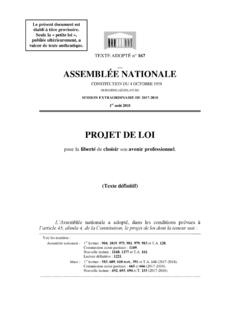Transcription of 50 REMBRANDT SIGNS HIS PAINTINGS: A TENTATIVE …
1 50. REMBRANDT SIGNS HIS PAINTINGS: A TENTATIVE typology . The scholar faced with the problem of REMBRANDT 's painted signatures may be likened to someone tackling the Gordian knot with a toothpick. The best thing to do is to find a friend with a good old- fashioned broadsword and have him take three good whacks at it. The result will be four not-so-neat chronological slices and a lot of frayed ends. The four slices, or periods, are: 1625-29, 1630-31, 1632 and 1633-69. The first period is characterized by signatures consisting of an initial "R" or paired initials often worked into a monogram "R," "RI," "RH," "RL" , and treated illusionistically (as if carved in stone), a classical design for history paintings. The "RH" monogram is the most frequent. A date is often included, sometimes separated from the signature by a dot. The initial "R" is traced in several strokes: REMBRANDT will give it its one-stroke, looped and definitive form only around 1629.
2 The second period, which covers the two years 1630-31, features a cursive monogram formed by three (presumably discrete) letters R,H,L , followed in most cases by the date (sometimes with a dot in between). This standard monogram is generally interpreted as the abbreviation for "Rembrant Harmensz. Leydensis" (Rembrant, son of Harmen, from Leiden;. see entry 40). In the third period, the single year 1632, the year of REMBRANDT 's establishment in Amsterdam, we see the standard monogram followed by a dot or wavy dash, the patronymic "van Rijn" (with an "R" usually formed without a loop) and the date. The whole a monogram completed by a patronymic makes for a rather puzzling formulation. At some time during this same year appeared the first-name form "Rembrant" written in a cursive italic script, followed by an abbreviation for fecit ("f.") and the date (with dots separating the different parts). During the first two years of the fourth and last period, 1633 and 1634, the simple "Rembrant" form persisted alongside the enhanced form " REMBRANDT ," both consistently followed by the "f" and a date.
3 This last signature became the form that he used, with few exceptions, until the end of his life to sign his works and legal documents. In 1633 REMBRANDT reworked the shapes of the letters "b" (in a gothic script, see entry 21) and "f" (made with a single, "elbowed" stroke, and tended more and more to omit the "t" of the fecit abbreviation if it indeed ever stood for a "t" (see entry 28). To my knowledge, no work bearing the date 1633 is signed "RHL-van Rijn," proving that there was nothing arbitrary about his use of the different versions of his signature. Each version replaced the preceding one, and if, for example, some paintings signed and dated 1634 still present the "Rembrant". form, this may be explained as a slip, pictorial necessity (the Prado Sophonisba, Br. 468) or as evidence of another hand, either contemporary or posthumous. Although the autograph nature of any given signature may be called into question, the general chronological sequence is straightforward.)
4 It points to a cogent and deliberate formulation of the signatures towards a definitive and very personal form: from a "nameless" sign to a first-person signature. This typology also applies to the signatures on the etchings, with the difference that the earliest ones (1626-27) are unsigned and the complete "RHL" monogram appeared there as early as 1628, while the "Rembrant" form occasionally occurs into the 1640s. In a previous entry I developed the idea that the etchings were REMBRANDT 's main field of experimentation and experience with the signatures (entry 6). Together with the large body of his early painted and etched self-portraits (over 20 between 1627-1632), REMBRANDT 's attention to and exploration of his signatures document an emerging self-awareness and a conscious "crafting" of his identity along the lines suggested by Svetlana Alpers and H. Perry Chapman. Jean-Marie Clarke All Rights Reserv






